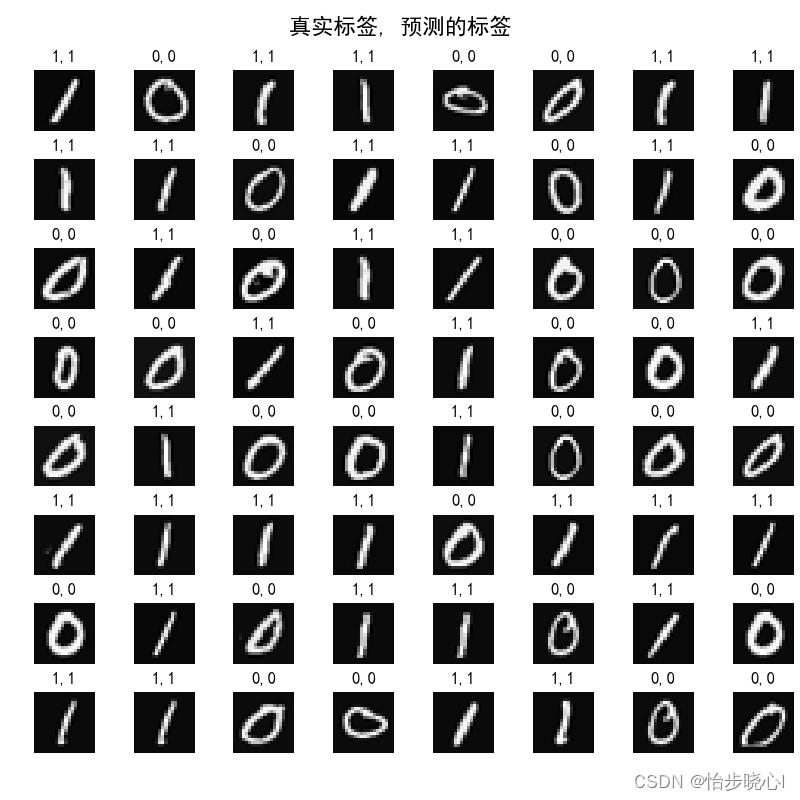01、Tensorflow實現二元手寫數字識別(二分類問題)
開始學習機器學習啦,已經把吳恩達的課全部刷完了,現在開始熟悉一下復現代碼。對這個手寫數字實部比較感興趣,作為入門的素材非常合適。
基于Tensorflow 2.10.0
1、識別目標
識別手寫僅僅是為了區分手寫的0和1,所以實際上是一個二分類問題。
2、Tensorflow算法實現
STEP1:導入相關包
import numpy as np
import tensorflow as tf
from keras.models import Sequential
from keras.layers import Dense
from sklearn.model_selection import train_test_split
import matplotlib.pyplot as plt
import warnings
import logging
from sklearn.metrics import accuracy_score
import numpy as np:這是引入numpy庫,并為其設置一個縮寫np。Numpy是Python中用于大規模數值計算的庫,它提供了多維數組對象及一系列操作這些數組的函數。
import tensorflow as tf:這是引入tensorflow庫,并為其設置一個縮寫tf。TensorFlow是一個開源的深度學習框架,它被廣泛用于各種深度學習應用。
from keras.models import Sequential:這是從Keras庫中引入Sequential模型。Keras是一個高級神經網絡API,它可以運行在TensorFlow之上。Sequential模型是Keras中的線性堆棧模型,允許你簡單地堆疊多個網絡層。
from keras.layers import Dense:這是從Keras庫中引入Dense層。Dense層是神經網絡中的全連接層,每個輸入節點與輸出節點都是連接的。
from sklearn.model_selection import train_test_split:這是從scikit-learn庫中引入train_test_split函數。這個函數用于將數據分割為訓練集和測試集。
import matplotlib.pyplot as plt:這是引入matplotlib的pyplot模塊,并為其設置一個縮寫plt。Matplotlib是Python中的繪圖庫,而pyplot是其中的一個模塊,用于繪制各種圖形和圖像。
import warnings:這是引入Python的標準警告庫,它可以用來發出警告,或者過濾掉不需要的警告。
import logging:這是引入Python的標準日志庫,用于記錄日志信息,方便追蹤和調試代碼。
from sklearn.metrics import accuracy_score:這是從scikit-learn庫中引入accuracy_score函數。這個函數用于計算分類準確率,常用于評估分類模型的性能。
STEP2:屏蔽無用警告并允許中文
logging.getLogger("tensorflow").setLevel(logging.ERROR)
tf.autograph.set_verbosity(0)
warnings.simplefilter(action='ignore', category=FutureWarning)
# 支持中文顯示
plt.rcParams['font.sans-serif']=['SimHei']
plt.rcParams['axes.unicode_minus']=False
logging.getLogger(“tensorflow”).setLevel(logging.ERROR):這行代碼用于設置 TensorFlow 的日志級別為 ERROR。這意味著只有當 TensorFlow 中發生錯誤時,才會在日志中輸出相關信息。較低級別的日志信息(如 WARNING、INFO、DEBUG)將被忽略。
tf.autograph.set_verbosity(0):這行代碼用于設置 TensorFlow 的自動圖形(Autograph)日志的冗長級別為 0。這意味著在將 Python 代碼轉換為 TensorFlow 圖形代碼時,將不會輸出任何日志信息。這有助于減少日志噪音,使日志更加干凈。
warnings.simplefilter(action=‘ignore’,category=FutureWarning):這行代碼用于忽略所有 FutureWarning 類型的警告。在 Python中,當使用某些即將過時或未來版本中可能發生變化的特性時,通常會發出 FutureWarning。通過設置action=‘ignore’,代碼將不會輸出這類警告,使控制臺輸出更加干凈。
plt.rcParams[‘font.sans-serif’]=[‘SimHei’]:這行代碼用于設置 matplotlib 中的默認無襯線字體為 SimHei。SimHei 是一種常用于顯示中文的字體,這樣設置后,matplotlib 將在繪圖時使用 SimHei 字體來顯示中文,從而避免中文亂碼問題。
plt.rcParams[‘axes.unicode_minus’]=False:這行代碼用于解決 matplotlib
中負號顯示異常的問題。默認情況下,matplotlib 可能無法正確顯示負號,將其設置為 False 可以使用 ASCII字符作為負號,從而正常顯示。
STEP3:導入并劃分數據集
劃分10%作為測試:
X, y = load_data()
print('The shape of X is: ' + str(X.shape))
print('The shape of y is: ' + str(y.shape))
X_train, X_test, y_train, y_test = train_test_split(X, y, test_size=0.1, random_state=42)
STEP4:模型構建與訓練
# 構建模型,三層模型進行分類,第一層輸入100個神經元...
model = Sequential([tf.keras.Input(shape=(400,)), #specify input size### START CODE HERE ###Dense(100, activation='sigmoid'),Dense(10, activation='sigmoid'),Dense(1, activation='sigmoid')### END CODE HERE ###], name = "my_model"
)
# 打印三層模型的參數
model.summary()
# 模型設定,學習率0.001,因為是分類,使用BinaryCrossentropy損失函數
model.compile(loss=tf.keras.losses.BinaryCrossentropy(),optimizer=tf.keras.optimizers.Adam(0.001),
)
# 開始訓練,訓練循環20
model.fit(X_train,y_train,epochs=20
)STEP5:結果可視化與打印準確度信息
原始的輸入的數據集是400 * 1000的數組,共包含1000個手寫數字的數據,其中400為20*20像素的圖片,因此對每個400的數組進行reshape((20, 20))可以得到原始的圖片進而繪圖。
# 繪制測試集的預測結果,繪制64個
fig, axes = plt.subplots(8, 8, figsize=(8, 8))
fig.tight_layout(pad=0.1, rect=[0, 0.03, 1, 0.92]) # [left, bottom, right, top]
for i, ax in enumerate(axes.flat):# Select random indicesrandom_index = np.random.randint(X_test.shape[0])# Select rows corresponding to the random indices and# reshape the imageX_random_reshaped = X_test[random_index].reshape((20, 20)).T# Display the imageax.imshow(X_random_reshaped, cmap='gray')# Predict using the Neural Networkprediction = model.predict(X_test[random_index].reshape(1, 400))if prediction >= 0.5:yhat = 1else:yhat = 0# Display the label above the imageax.set_title(f"{y_test[random_index, 0]},{yhat}")ax.set_axis_off()
fig.suptitle("真實標簽, 預測的標簽", fontsize=16)
plt.show()# 給出預測的測試集誤差
y_pred=model.predict(X_test)
print("測試數據集準確率為:", accuracy_score(y_test, np.round(y_pred)))
3、運行結果
按照最初的劃分,數據集包含1000個數據,劃分10%為測試集,也就是100個數據。結果可視化隨機選擇其中的64個數據繪圖,每個圖像的上方標明了其真實標簽和預測的結果,這個是一個非常簡單的示例,準確度還是非常高的。


4、工程下載與全部代碼
工程鏈接:Tensorflow實現二元手寫數字識別(二分類問題)
import numpy as np
import tensorflow as tf
from keras.models import Sequential
from keras.layers import Dense
from sklearn.model_selection import train_test_split
import matplotlib.pyplot as plt
import warnings
import logging
from sklearn.metrics import accuracy_scorelogging.getLogger("tensorflow").setLevel(logging.ERROR)
tf.autograph.set_verbosity(0)
warnings.simplefilter(action='ignore', category=FutureWarning)
# 支持中文顯示
plt.rcParams['font.sans-serif']=['SimHei']
plt.rcParams['axes.unicode_minus']=False# load dataset
def load_data():X = np.load("Handwritten_Digit_Recognition_data/X.npy")y = np.load("Handwritten_Digit_Recognition_data/y.npy")X = X[0:1000]y = y[0:1000]return X, y# 加載數據集,查看數據集大小,可以看到有1000個數據集,每個輸入是20*20=400大小的圖片
X, y = load_data()
print('The shape of X is: ' + str(X.shape))
print('The shape of y is: ' + str(y.shape))
X_train, X_test, y_train, y_test = train_test_split(X, y, test_size=0.1, random_state=42)# # 下面畫圖,隨便從原數據取出幾個畫圖,可以注釋
# m, n = X.shape
# fig, axes = plt.subplots(8, 8, figsize=(8, 8))
# fig.tight_layout(pad=0.1)
# for i, ax in enumerate(axes.flat):
# # Select random indices
# random_index = np.random.randint(m)
# # Select rows corresponding to the random indices and
# # 將1*400的數據轉換為20*20的圖像格式
# X_random_reshaped = X[random_index].reshape((20, 20)).T
# # Display the image
# ax.imshow(X_random_reshaped, cmap='gray')
# # Display the label above the image
# ax.set_title(y[random_index, 0])
# ax.set_axis_off()
# plt.show()# 構建模型,三層模型進行分類,第一層輸入25個神經元...
model = Sequential([tf.keras.Input(shape=(400,)), #specify input size### START CODE HERE ###Dense(100, activation='sigmoid'),Dense(10, activation='sigmoid'),Dense(1, activation='sigmoid')### END CODE HERE ###], name = "my_model"
)
# 打印三層模型的參數
model.summary()
# 模型設定,學習率0.001,因為是分類,使用BinaryCrossentropy損失函數
model.compile(loss=tf.keras.losses.BinaryCrossentropy(),optimizer=tf.keras.optimizers.Adam(0.001),
)
# 開始訓練,訓練循環20
model.fit(X_train,y_train,epochs=20
)# 繪制測試集的預測結果,繪制64個
fig, axes = plt.subplots(8, 8, figsize=(8, 8))
fig.tight_layout(pad=0.1, rect=[0, 0.03, 1, 0.92]) # [left, bottom, right, top]
for i, ax in enumerate(axes.flat):# Select random indicesrandom_index = np.random.randint(X_test.shape[0])# Select rows corresponding to the random indices and# reshape the imageX_random_reshaped = X_test[random_index].reshape((20, 20)).T# Display the imageax.imshow(X_random_reshaped, cmap='gray')# Predict using the Neural Networkprediction = model.predict(X_test[random_index].reshape(1, 400))if prediction >= 0.5:yhat = 1else:yhat = 0# Display the label above the imageax.set_title(f"{y_test[random_index, 0]},{yhat}")ax.set_axis_off()
fig.suptitle("真實標簽, 預測的標簽", fontsize=16)
plt.show()# 給出預測的測試集誤差
y_pred=model.predict(X_test)
print("測試數據集準確率為:", accuracy_score(y_test, np.round(y_pred)))








)










